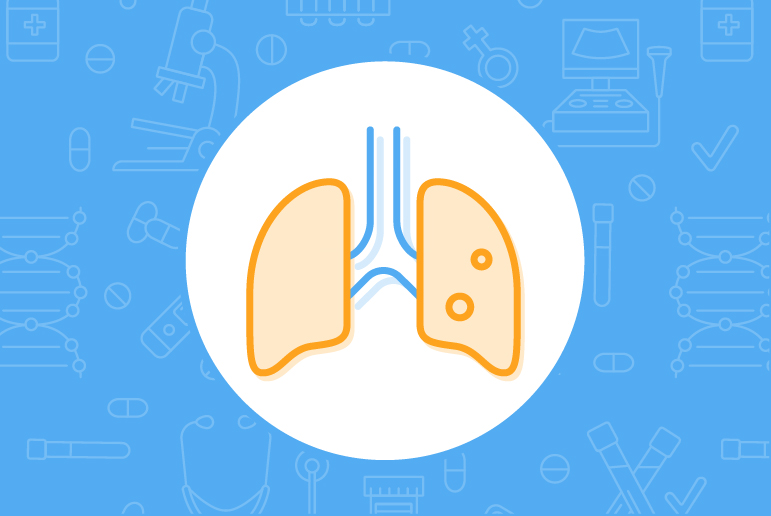What is Lung Cancer?
What is Lung Cancer?
The lungs are an essential part of the respiratory system. The respiratory system consists of a pair of lungs that also have different parts. The right lung has three lobes, and the left lung has two. A thin layer called the pleura to protect the lungs. Cells in the lungs do tend to change and can grow or stop behaving normally. Some of these cells can grow into benign, non-cancerous tumors or malignant tumors. These cells can destroy the nearby tissue and can also spread to other parts of the body, causing lung cancer.
Lung cancers can be primary and secondary, depending on the location that it starts. Primary tumors in the lungs start locally, and secondary ones start in another part of the body and spread to the lungs. It is also further divided into non-small cell lung cancer and small cell lung cancer, depending on the appearance of the cancer cells under the microscope.

What are the different types of Lung Cancer?
The lungs are part of the respiratory system. The cells in the lungs do tend to change and can grow or stop behaving normally. Some of these cells can grow into noncancerous benign tumors, and some can grow into cancer. These cells can destroy the nearby tissue and can also spread to other parts of the body — lung cancer comprises of different types and grades.
The type of lung cancer that a person has can help doctors understand the cell that cancer started in. Lung cancer is of two common types, small cell lung cancer, and non-small cell lung cancer. Lung cancer can also be of the primary and secondary type depending on the origin of cancer. Primary lung cancer is the one that starts in the lungs, and secondary lung cancer is the kind of cancer that starts in another part of the body and spreads to the lungs.
Small cell lung cancer
This type of cancer has been characterized by small cells that multiply very quickly and form large tumors that spread throughout the body. This kind of cancer is common among smokers. Also called oat-cell cancer; it constitutes about 10-15% of all lung cancer.
Non-small cell lung cancer
Non-small cell lung cancer constitutes about 80% of the lung cancer cases, and it further comprises four different types depending on the cell of origin.
Adenocarcinoma
Adenocarcinoma forms the mucus-producing glands and is the most common in women and non-smokers.
Bronchi alveolar carcinoma
This type of cancer forms near the air sacs of the lungs
Squamous cell carcinoma
Squamous cell carcinoma forms in the lining of the bronchial tubes, commonly seen in smokers.
Large cell carcinoma
Large cell carcinomas form near the outer edges or surface of the lungs. This type of cancer is rare.
Other types of lung cancer
Pancoast tumors
Pancoast tumors are the kind that affects the top part of the lungs.
Mesothelioma
Mesothelioma is the kind of cancer that affects the covering (the pleura) of the lungs.
What are the signs and symptoms of Lung Cancer?
The most common early signs and symptoms of lung cancer are listed below
- Wheezing
- Shortness of breath
- Cough
- Weight loss
- Fatigue
- Weakness
- Recurrent chest infections like bronchitis
- A build-up of fluid around the lungs
- Chest pain
- Blood in the mucus when coughed up from the lungs
What are the causes of Lung Cancer?
A risk factor is something that increases the chances of developing the disease. It could either be a condition or a substance. The chance of developing lung cancer increases with age. Smoking tobacco is known to be the most critical risk factor in the case of lung cancer. The following are a few causes of lung cancer.
What are the common risk factors that can lead to lung cancer?
The most common risk factors for lung cancer:
Smoking
Smoking cigarettes are known to be the leading cause of developing lung cancer as the smoke from cigarettes contains chemicals known as carcinogens. Carcinogens are chemicals that cause changes in the cells in the lungs, which results in cancer.
The risk of developing lung cancer has many other factors involved. Namely, the age at which a person started smoking, the number of cigarettes smoked in a day and for how long the person has continued smoking.
Passive smoking
The inhaling of secondhand smoke or passive smoking is one of the leading risk factors among non-smokers. The breathing in secondhand smoke is as harmful as smoking a cigarette as it contains the same amount of chemicals when inhaled.
Exposure to radiation
People exposed to atomic bomb explosions or nuclear accidents are at a higher risk of developing lung cancer. People who have also undergone radiation therapy for certain cancers like breast cancer also are at a higher risk of developing lung cancer.
Radon
Radon is a colorless, odorless gas that comes from the breakdown of uranium in the soil and rocks. Outdoors the gas is diluted with fresh air, so it is usually not a concern, but radon can seep into buildings through cracks in the foundation and dirty floors. The radon gas, when breathed in can cause damage to the cells that line the lungs. Radon is a leading cause of cancer in non- smokers. Furthermore, lung cancer risk increases with exposure to gas.
Occupational exposure to certain chemicals
People exposed to particular carcinogens at work are at higher risk of developing lung cancer. An example of these carcinogens would be arsenic and inorganic arsenic compounds, silica dust, chromium, cadmium, and mustard gas.
Asbestos
The asbestos fiber is a silicate that can last a lifetime in the lungs. The workplace is the most common area for exposure to asbestos fibers, and this kind of exposure occurs in industries that make both thermal and acoustic insulation materials. Research has linked the risk of developing lung cancer to exposure to asbestos.
Air Pollution
Constant exposure to polluted air is a cause of lung cancer. Polluted air is as harmful as cigarette smoke, and some lung cancer deaths occur on account of the smoke.
Prior history of lung cancer
People who have had lung cancer before are at higher risk of developing it again in comparison to the general population who have not had a history of lung cancer before. People who have had non-small cell lung cancer have an added risk of 1 to 2% per year, and people who have had small cell lung cancer have an added risk of 6% per year.
What are the stages of Lung Cancer?
Stages of Small cell lung cancer (SCLC)
Staging of small cell lung cancer is an important process and the stage of the cancer is determined to through tests performed at the time of diagnosis. The stage of cancer can also give out information on how big the tumor is and how far cancer has spread. Staging also allows doctors to decide what kind of treatment can be given.
Small cell lung cancer is mainly caused by tobacco smoking. Small cell lung cancer starts in the bronchi and slowly spreads to other areas. However, for small cell lung cancer, the staging process is done differently and it is classified as either limited stage or extensive-stage disease.
Limited stage SCLC
At this stage, the cancer is found in one lung and sometimes in the lymph nodes too.
Extensive stage SCLC
At this stage, cancer has spread to the other lung and to the fluid in the lungs as well. Cancer might have spread to other parts of the body too.
Stages of non small cell lung cancer (NSCLC)
Staging of lung cancer is an important process and the stage of the cancer is determined to through tests performed at the time of diagnosis. The stage of cancer can also give out information of how big the tumor is and how far the the cancer has spread. Staging also allows doctors to decide what kind of treatment can be given.
Non-small cell lung cancer uses the TNM system of staging.
Tumor (T): The size of the original tumor is described
Lymph nodes (N): This factor indicates if the cancer has spread to the lymph nodes
Metastasis (M): This factor refers to whether the cancer has spread to other parts of the body.
A number or letter is assigned to each factor and as the number increases so does the severity. For example, T1 is a lower score in comparison to T2 and indicates the tumor is of a smaller size. After the TNM system of staging is done, an overall stage is determined.
Stage 1 Non small cell Lung cancer (NSCLC)
Stage 2 Non small cell Lung cancer (NSCLC)
How do I know if I have Lung Cancer?
Although breast cancer has certain symptoms, many women do not experience any symptoms in the early stages. Cancer discovered in the early stages has a higher chance of a successful prognosis. This is why screening tests play an important role in detecting the cancer in the early stages.
If a woman does not have a family history of breast cancer and has not been exposed to chest radiation therapy, then she is considered to be an average risk of breast cancer. A woman with average risk is recommended a mammogram every year, after the age of 40 years. After the age of 55, this can be reduced to a mammogram once in two years, if no cancer has been detected so far.
It is recommended that all women examine their breasts regularly to spot any signs or symptoms of breast cancer. Women should be familiar with how their breasts look and feel and should be able to spot any changes which need to be reported to a doctor. The most common symptom of breast cancer is a lump in the breast. Self-examination helps in the detection of such lumps while they are still small and can be surgically remov
Screening refers to a type of test that is performed to detect the cancer at the earliest, in the absence of clear symptoms. Screening may include a number of tests such as bloods tests, fluid tests and various forms of. Imaging that help doctors trace the cancer at the earliest treatable stage. Screening also enables a person to understand if they are at a higher risk of developing cancer and diagnose lung cancer.
In the case of lung cancer, there are different systems used for screening and they are listed below.
Low-dose computed tomography (LDCT)
In the case of lung cancer, low dose computed tomography is conducted on individuals who have a higher risk of developing lung cancer but show no signs and symptoms. In this kind of a screening method, X-ray machines are combined with a computer to give a cross-sectional view of the lungs. LDCT is the most common method used as the images produced are of good quality and the abnormalities that can be detected are up to 90%.
Chest X-ray
A chest x-ray is particularly used in emergency diagnosis and treatment as it is a fast method. In the chest x-ray method, a very small dose of ionizing radiation is used to produce images of the organs like the lungs, liver heart etc. A chest x-ray is also used to detect other lung conditions like pneumonia. This method of screening is most commonly used to evaluate symptoms like shortness of breath, chest pain and persistent cough.
Sputum cytology
Sputum cytology is a kind of diagnostic test that is conducted wherein a sample of the mucus that contains blood is taken and view under a microscope to check for the presence of abnormal cells.
ed from the breast.
To learn more about the screening tests for breast cancer and how to conduct self-examination of your breasts.
What is lung cancer diagnosis?
The diagnostic tests used for lung cancer can vary from patient to patient. There are also numerous other factors that doctors look into while diagnosing a patient such as medical history, symptoms, and findings from previously conducted physical examinations. Enlisted below are a few tests recommended for lung cancer diagnosis.
Common diagnostic methods for lung cancer:
Imaging tests
Imaging tests are essential for lung cancer diagnosis. They help doctors understand the location of the tumor, the grade of metastasis, treatment outcomes, and they help predict cancer recurrence. Listed below are various imaging tests:
Computed tomography (CT)
In this kind of an imaging method, X-ray machines project a cross-sectional view of the lungs on a cmputer. CT is the most commom as the images produced are of good quality, and the detection of abnormalities are up to 90%.
Positron emission tomography (PET) scan
In a PET scan, the a type of radioactive sugar is injected into the patient’s bloodstream. Since the cancer cells consume large amounts of sugar quickly, a camera is spots this kind of radioactivity. More importantly, this type of imaging test helps understand if cancer has spread to other parts of the body.
Other procedures used in the diagnosis of lung cancer
Doctors collect tissue or fluid from around the lungs and carefully test it to see if cancer cells are present in the lungs. The tests are:
Sputum cytology
Sputum cytology is a diagnostic test in which you pathologist studies a sample mucus containing blood under a microscope to check for the presence of abnormal cells.
Bronchoscopy
Doctors use the process of bronchoscopy to usually check if there is a tumor or fluid in the lungs. A bronchoscope (a tube) passes through the nose or mouth and into the lungs.
Mediastinoscopy
Mediastinoscopy is a kind of endoscopy in which a surgeon incises the base of the neck. Surgical tools are inserted behind the breastbone to take tissue samples from the lymph nodes.
Fine needle biopsy (FNAC)
Firstly, in a needle biopsy test, a fine needle scrapes off cells from the affected area. A pathologist then examines these cells under a microscope to see if they are cancerous.
Biopsy
In a biopsy, doctors remove some tissue and study it under a microscopea and pathologist identifies if it is cancerous or not. There are other tests that can suggest if the tissue is cancerous, but a biopsy is a more definitive method. Moreover, it is a standard gold test for cancer diagnosis.
Besides that, doctors recommend a biopsy after a USG or CT scan or along with bronchoscopy or mediastinoscopy.
How is Lung Cancer treated?
Lung cancer treatment depends on its pathological type. Lung cancers are broadly divided into two types, Non small cell lung cancer (NSCLC) and small cell lung cancer. NSCLC again divided into squamous, adeno and other type of cancers. Lung cancer is treated with multiple different modalities and the chosen sequence and type of modality often depends on the type of cancer that the patient has and how far the cancer has spread.
What are the treatment options for non-small cell lung cancer?
Non-small cell lung cancer has a variety of treatment options that include:
Surgery
Surgical options for lung cancer are usually done in stage 1 and stage 2, this procedure of treatment is mainly done to remove the tumor. The extent of surgery may be from segmentectomy (small lung part ) to Pneumonectomy (whole single side lung)
Chemotherapy
In the case of non small cell lung cancer studies have shown that, when patients are given adjuvant chemotherapy, which is chemotherapy that has been given after the surgical removal of the tumor, the cancer has very little chances of coming back. For people with stage 3 lung cancer, chemotherapy is given in combination with radiation as the tumor cannot be surgically removed. In stage 4 chemotherapy or targeted therapy is considered to be the main treatment.
Neoadjuvant treatment
Neoadjuvant treatment is treatment where chemotherapy is given before surgery or radiation. This kind of treatment may help with shrinking the tumor into a smaller size which makes it easier to remove it surgically.
Targeted treatment
Targeted treatment is the kind of treatment that is designed specifically to attack only the cancer cells by attaching or blocking targets (specific proteins) that appear on the surface of the cancer cells.
Immunotherapy
Immunotherapy has become the newest method of treatment for lung cancer. Immunotherapy is a well tolerated treatment and causes minimal sides effects because of its mechanism of action. Immunotherapy is of four categories:
- Monoclonal antibodies
These are lab generated antibodies that target specific tumor antigens in the body - Checkpoint inhibitors
These are target molecules and act as checkers, they also balance and regulate immune responses. - Therapeutic vaccines
These act tumor specific vaccines - Adoptive T-cell transfer
In this approach T-cells, which are a kind of white blood cells are removed from the patient’s body and are chemically treated to enhance the chemical response and are reintroduced into the patient’s body to enhance the immune systems anticancer response.
What are the treatment options for small cell lung cancer?
Small cell lung cancer has three main treatment options and they are listed below:
Chemotherapy and radiation
For people with small cell lung cancer, regardless of what stage the cancer is at, chemotherapy is an important treatment. For people with limited stage small cell lung cancer, they are given chemotherapy in combination with radiation and for people with extensive stage small cell lung cancer they are given chemotherapy alone.
Preventive radiation therapy
Preventive radiation therapy is mainly used in patients who’s lung cancer has responded well to chemotherapy and preventive radiation therapy is prescribed to stop cancer from spreading to the brain, because with small cell lung cancer, there is a tendency for the cancer to spread to the brain.
Surgery
A very small percentage of people with limited stage small cell lung cancer benefit from surgery only if there are no lymph node tumors. After the surgery , they are given adjuvant chemotherapy.
Advanced And Targeted Treatment Options For Lung Cancer
Targeted therapy specifically targets cancer cells. It is very different from chemotherapy. Targeted treatment works by target specific genes or proteins to stop the lung cancer cells from growing or multiplying. Doctors often use advanced and targeted treatment for lung cancer with chemotherapy and other modalities.
What are the objectives of targeted treatment?
Cancer starts when genes in a healthy cell change and this known as a gene mutation. In targeted therapy, drugs block proteins that help in cell division or cell growth. They ultimately killing cancer cells. Consequently, the targeted therapy drugs carry out the following functions:
- Firstly, they destroy cancer cells
- Secondly, they keep cells from living longer than normal
- Finally, they block or turn off signals that tell cancer cells to grow and divide
Types of targeted treatments for lung cancer
There are two main types of targeted treatment, namely:
Monoclonal Antibodies
Drugs known as monoclonal antibodies are drugs that target the outside of a cancer cell or the area around the cancer cells. They sometimes send toxic substances to the cancer cells. This kind of treatment helps patients with chemotherapy and radiation. The drugs used here are often administered intravenously. They are known as anti-angiogenesis inhibitors. Anti-angiogenesis inhibitors are drugs that keep the tissue around the tumor from growing by stopping the blood supply
Small molecule drugs
Small molecule drugs block the process that helps cancer cells grow and multiply. These drugs are usually oral pills.











